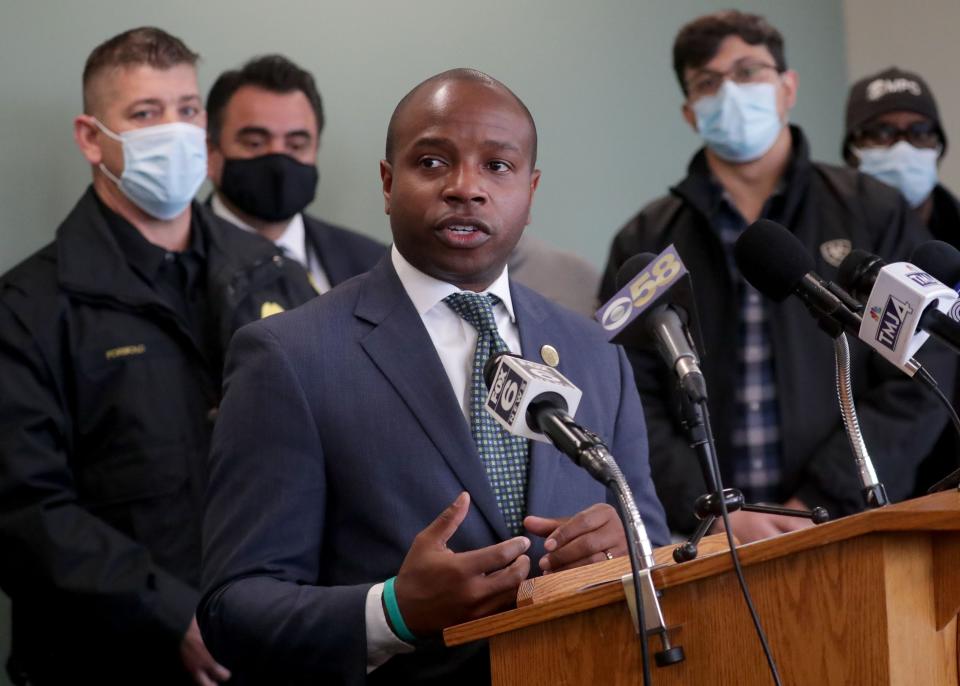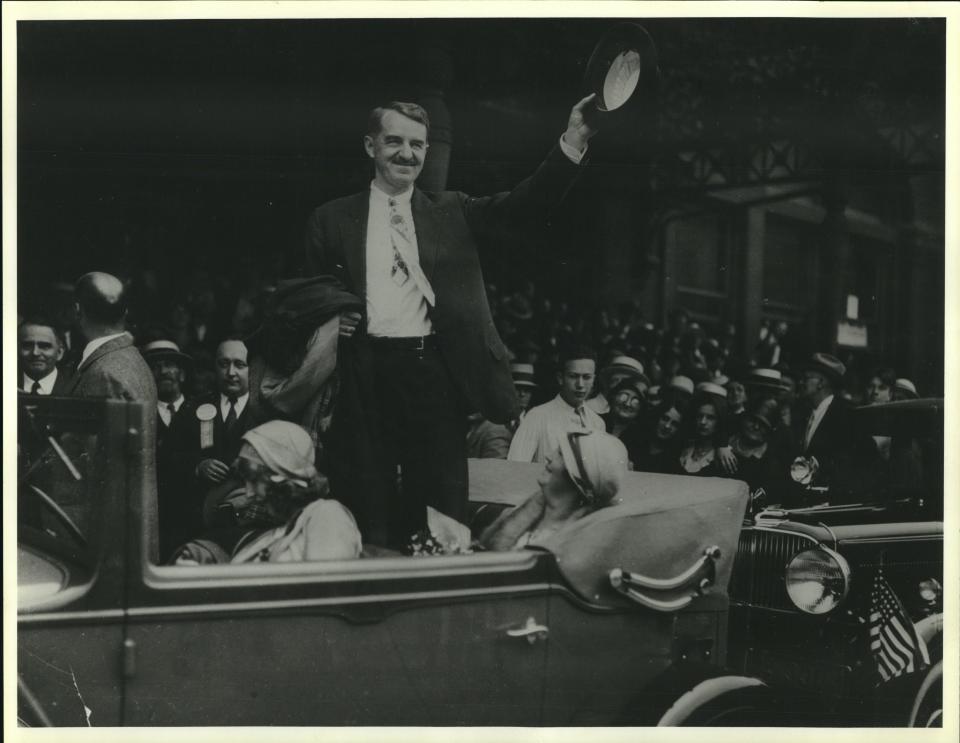A century of Milwaukee mayors, from Dan Hoan to Cavalier Johnson: How they got in, and how they left

When Common Council President Cavalier Johnson took over as acting mayor of Milwaukee Dec. 22, he became just the ninth person in the last 100 years to hold that office. Voters gave him the job outright April 5, 2022.
Some of his predecessors were only in the job for months; two of them camped out in City Hall for more than 20 years.
Here's a look at who's been Milwaukee mayor, how they got there and how they left over the past century.
Dan Hoan

In office: 1916-'40
How he got in: Running as a Socialist candidate, he defeated incumbent Gerhard Bading, who had been elected twice representing the Fusion Party, a Republican-Democrat coalition.
Highlights: In his tenure, city finances were stabilized, Milwaukee was named "healthiest city" three years running, and Hoan became known nationally as a reformer and a royalty-hater (he drew national headlines for refusing to greet the king and queen of Belgium when they visited the city).
How he left: He was upset in an election by political novice Carl Zeidler.
Lasting traces: Before it was even connected to the rest of I-794, the Daniel Webster Hoan Bridge opened to traffic in 1977.
Carl Zeidler

In office: 1940-'42
How he got in: An assistant city attorney, he ran a very modern campaign filled with stunts — and singing — and upset Socialist Dan Hoan, who had been in office for 24 years.
Highlights: He became known as "the singing mayor," but Zeidler's stay in office was overshadowed by World War II.
How he left: Shortly after the attack on Pearl Harbor, Zeidler enlisted and was granted a leave of absence. He was assigned to the U.S. Naval Reserve, which sent him on a Merchant Marine ship in September 1942. A few weeks later, the ship was sunk and Zeidler was never heard from again.
Lasting traces: A park at 301 W. Michigan St. was renamed Carl Zeidler Park in 1969. (The park's name changed to Zeidler Union Square in 1995.)
John Bohn

In office: 1942-'48
How he got in: Bohn, who had been an alderman since 1916, was president of the Common Council when Carl Zeidler resigned, making him acting mayor. He was elected to the job outright in 1944.
Highlights: Bohn advocated low-cost housing, urban renewal (at the time, it was called "slum clearance") and more public transportation during his tenure in office.
How he left: At the age of 81 in 1948, he opted not to run for re-election.
Frank Zeidler

In office: 1948-'60
How he got in: In the first open election for the mayor's office in decades, Zeidler, a Socialist, defeated Henry Reuss. (Reuss was elected to Congress in 1954, and served until 1983.)
Highlights: Zeidler pushed annexation of surrounding towns, nearly doubling the city's size. He also promoted the development of more public housing and was an early advocate of freeway construction.
How he left: Zeidler decided not to run for re-election in 1960. He remained active in Socialist politics and was the Socialist Party's candidate for president in 1976.
Lasting traces: The city's main administrative building, 841 N. Broadway, was renamed the Frank P. Zeidler Municipal Building in 1995.
Henry Maier

In office: 1960-'88
How he got in: After losing a bid for mayor in 1948, Maier was elected to the state Senate in 1950. He defeated Henry Reuss (yes, Reuss lost again) in his second run for mayor in 1960.
Highlights: Milwaukee's second "singing mayor" was known for battling the city's suburbs, newspapers and, sometimes, its residents in his 28-year tenure at City Hall. His unrelenting cheerleading led to the creation of Summerfest, a string of ethnic festivals, parades, and a plan to make Milwaukee "the city of flags, festivals and fountains."
How he left: Maier decided not to run for re-election when his term ended in 1988.
Lasting traces: The Summerfest grounds along Milwaukee's lakefront were renamed Henry W. Maier Festival Park in 1986.
John Norquist

In office: 1988-2004
How he got in: He defeated rival Democrat Martin Schreiber.
Highlights: Norquist, a strong-willed member of the Wisconsin Legislature since 1975, touted what's now called "the New Urbanism," successfully getting the Park East Freeway torn down to open up land north of downtown and lobbying, unsuccessfully for a new downtown stadium for the Brewers.
How he left: After settling a sexual harassment claim brought by a former staffer, Norquist announced in 2002 that he would not seek re-election. The next year, he said he would resign to take a job as head of the Congress for the New Urbanism but didn't leave office until early 2004.
Marvin Pratt
In office: 2004 (acting mayor)
How he got in: As president of the Common Council, Pratt became acting mayor in January 2004 when John Norquist formally resigned.
Highlights: The 18-year Common Council veteran was Milwaukee's first Black mayor, even though he didn't get to have much time in office that wasn't spent campaigning to keep the job.
How he left: Running for the office outright, Pratt was defeated by Tom Barrett in April 2004.
Lasting traces: The former Silver Spring Elementary School on Milwaukee's near northwest side was renamed Marvin E. Pratt Elementary School in 2016.
Tom Barrett

In office: 2004-'21
How he got in: Barrett, who had served in the Assembly and state Senate for eight years and in the U.S. House of Representatives for another 12, defeated Acting Mayor Marvin Pratt to win the mayor's office.
Highlights: Redevelopment efforts in the Menomonee Valley, the Harbor District and the former Pabst Brewing complex took place during his tenure, which also included, as with his predecessors, battles with state government over funding and a still-ongoing struggle for racial equity in housing and policing.
How he left: Barrett resigned in December 2021 to become the U.S. ambassador to Luxembourg.
Cavalier Johnson

In office: 2021- .
How he got in: Johnson, as president of the Common Council, became acting mayor on Dec. 22, 2021, when Tom Barrett formally resigned the post to become the U.S. ambassador to Luxembourg. He was elected to the job outright on April 5, 2022.
Editor's note: An earlier version of this story incorrectly stated that Mayor Carl Zeidler resigned to enlist in the armed forces in 1942; he was granted a leave of absence. It also incorrectly reported that Henry Reuss was a Democrat when he ran for mayor in 1948 and lost to Frank Zeidler. He was a Republican until 1950, when he switched parties.
Sources: Journal Sentinel files, Encyclopedia of Milwaukee (emke.uwm.edu)
Contact Chris Foran at chris.foran@jrn.com. Follow him on Twitter at @cforan12.
Our subscribers make this reporting possible. Please consider supporting local journalism by subscribing to the Journal Sentinel at jsonline.com/deal.
DOWNLOAD THE APP: Get the latest news, sports and more
This article originally appeared on Milwaukee Journal Sentinel: 100 years of Milwaukee mayors, from Dan Hoan to Cavalier Johnson

 money
money 